
With its easy to understand and gentle explanations, step by step, guided approach and through coverage of concepts, Learn Math Fast can be a great way to make math learning more effective, comfortable and (perhaps most importantly) tear-free for all involved.
What We Like
But watch out for…
What Is The Learn Math Fast System?
Designed by homeschooling mom and author JK Mergens, the Learn Math Fast System is a math curriculum designed to help students in elementary through high school learn essential math concepts quickly and easily.
Throughout its series of books, the program teaches using a combination of gentle and conversationally written textbook instruction, assorted worksheets, quizzes, tests, cards, charts and even the occasional math manipulative.
What Ages of Grade is Learn Math Fast Intended For?
Learn Math Fast covers math topics for grades 1 through high school, or from basic number sense, adding and subtracting to high school geometry.
The program is divided into seven volumes:
| Volume | Title | Approximate Grades |
| Volume 1 | Math Facts | 1-3 |
| Volume 2 | Fractions and Percentages | 4-5 |
| Volume 3 | Pre-algebra | 6-8 |
| Volume 4 | Basic Geometry | 3-7 (geometry concepts) |
| Volume 5 | Algebra 1 | HS Algebra 1 |
| Volume 6 | Algebra 2 | HS Algebra 2 |
| Volume 7 | High school geometry | HS Geometry |
As a homeschool math program, Learn Math Fast books can, of course, be used by students of any grade level.
Unlike many more traditional math curricula out there, Lean Math Fast doesn’t actually mention any grade or age level for its books, instead referring to them as “volumes” and containing concepts that span multiple grades, as can be seen in the chart above.
As a result, it can be appropriate for students learning outside of a typical grade progression, such as advanced students who want to dive into more complex math topics earlier on or students who need a bit of remediation.
In fact, we feel that the series structure and naming convection makes Learn Math Fast particularly well-suited for students who are behind or struggling in math, as the lack of any grade level references can make it more comfortable and less embarrassing for such students when working from earlier volumes.
Placement Tests
One thing that can be an issue with non-grade specific curricula and workbooks is that it can be hard for some parents, particularly those switching in from another program or from a traditional school, to figure out where to start.
This can be a little more challenging with Learn Math Fast as some of its books can include math concepts that are traditionally introduced and covered across several grade levels.
Fortunately, the company offers free placement tests that parents can use to help figure things out.
The placement tests are offered in a couple different formats, but are largely similar in content.
The online version is a fairly straightforward interactive, online multiple choice quiz whose 45 questions gradually increase in difficulty as they work their way up through math concepts.
Students answer questions until they get one wrong, whereupon they can stop at that level or try it again.
In either case, the online test will offer an instant recommendation of where to begin, as well as providing some rather helpful information as to the particular skill that gave the student a hard time.
Parents should keep in mind that the online test can be a bit long, particularly as it presents questions one at a time, and probably will require most students to have some scrap paper handy.
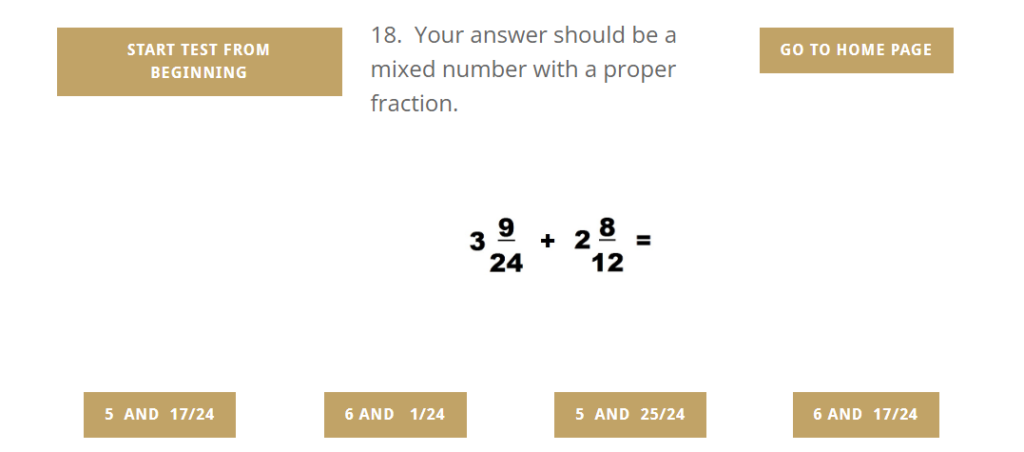
The resulting recommendation, however, is a little more gentle and careful with its words than other programs, which is quite nice and can help preserve a student’s self-esteem, something that can be particularly important for those who have struggled with math in the past.
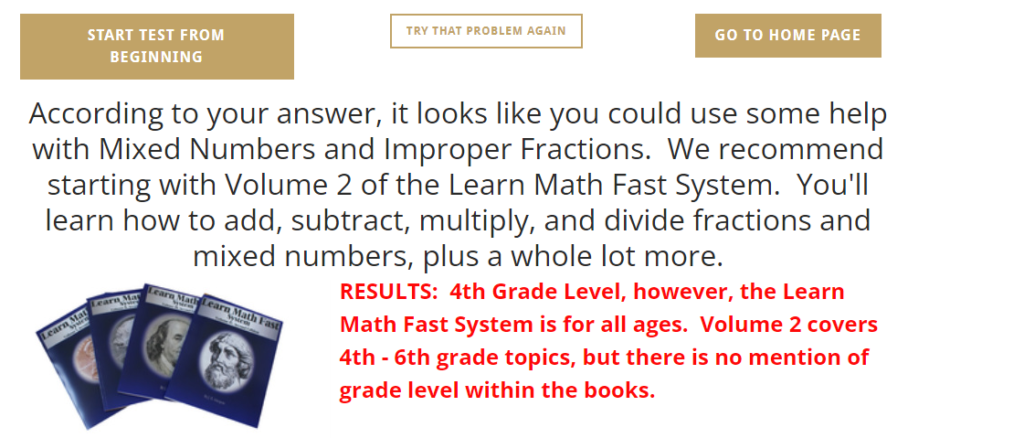
For those who would prefer to work offline or in a more traditional manner, there is a paper version of the placement test, as well.
A PDF document that parents can download and print, the paper placement test also has some 45 questions that students are expected to work through and, rather than providing instant results, parents use a separate answer key to score it.
The paper test follows the same concept as the online test – students continue to work until they start getting answers wrong, at which point they are directed to start at that level.

Overall, the placement tests are pretty straightforward and can give parents a good overall picture of their students ability.
However, parents should be aware that the need to get all questions correct in order to advance can sometimes make the tests a bit more high-stakes for students, which can make the tests a little more stressful if parents aren’t careful.

Fortunately, if students find this a little stressful it shouldn’t be too hard for parents to adjust things to fit student needs.
What’s Included or Needed to Use The Learn Math Fast System
Learn Math Fast is a pretty compact curriculum compared to many other homeschool math programs out there.
That is to say, the program doesn’t use any teacher’s guides, student editions or separate student workbooks, so there isn’t a lot that parents will have to buy, organize and keep track of.
Instead, the program largely teaches using a single textbook, which contains most everything a student and parent would need to learn math.

These largely black and white softcover books include the instructional material, exercises and worksheets for practice and an assortment of tests (and answers) that parents can use to measure student progress.
The books themselves are pretty compact, at least compared to typical math textbooks, coming in at around 100-250 pages each.
The books present their information using a casual, sort of conversational tone.
In this way, they are able to present math concepts in a clearer and more understandable manner while also making math seem more approachable and less intimidating for students, especially compared to the neutral and dry tone of a typical math textbook.
At the same time, they manage to present math concepts in a complete and professional way – at no time did we feel that the textbooks to be condescending, nor did we feel that they “dumbed down” the material in any way, which is something we appreciate from approachable STEM programs.
The worksheets and exercises are printed in the book, along with their solutions, which is quite convenient as it helps keep everything in one place.
Unfortunately, the back of these worksheets often have lessons printed on their reverse, so they can’t readily be torn out and given to students.
Helpfully, the company has recognized this issue and offers parents printable PDFs on the company website that they can use instead.
Although this does require an extra step on the part of parents, it does mean that the Learn Math Fast textbooks are somewhat non-consumable and can therefore be reused later on with younger siblings.
Interestingly, there are also supplementary worksheets that students can download, which adds more optional problems to the program, addressing an issue many parents have had with the program in the past.
These supplemental worksheets correlate to each lesson and topic and provide students with a little bit more focused practice to lessons.

In a similar vein, the program’s various tests and quizzes are also printed in the textbooks, along with their answers, which are located in the back.
This, of course, means that parents will have to keep an eye on students during assessments to make sure they don’t succumb to the temptation to sneak a peek at the answer sheet.
One thing we like is that, at the beginning of the series, the authors have included a brief section on how to use the series that includes ideas for how to differentiate the learning to different age groups, which can be very helpful for parents working with students outside a typical grade level and those looking to remediate.
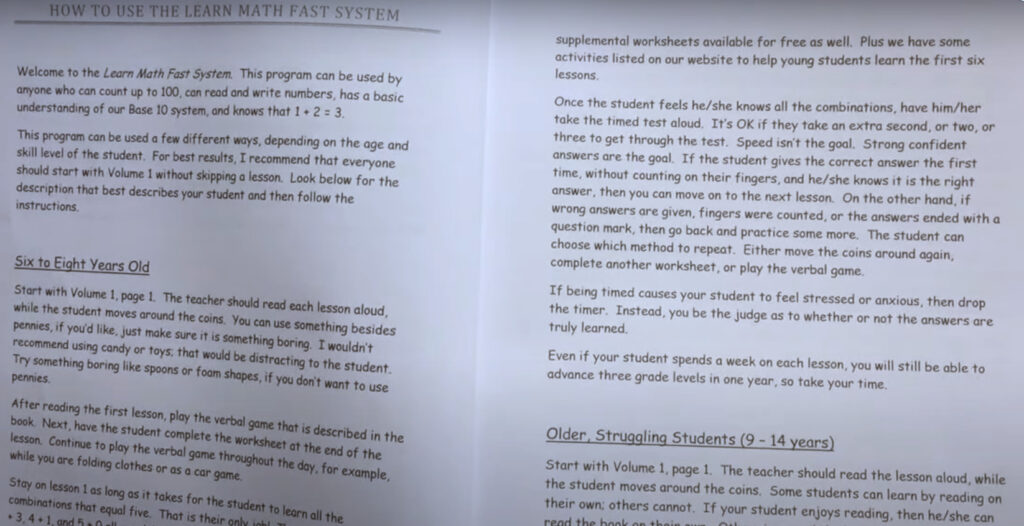
On the downside, while Learn Math Fast books are straightforward and clearly laid out, they aren’t the most visually stimulating math texts we’ve ever seen, particularly when compared to curricula that use a lot of visuals and/or artwork like Simply Good and Beautiful Math, Unlock Math or even Primary Mathematics.
While perhaps not much of an issue for older students (in fact it can be a lot less distracting), the lack of pictures, colorful imagery and so on can make the books seem a bit more boring for younger kids.
Approach to Teaching Math
Mastery Approach
Learn Math Fast is a mastery math program.
In other words, its topics and concepts (such as fractions, for example) are introduced and studied one at a time, with students spending several lessons on them, diving deeply into each concept and only really moving forward to the next when they’ve achieved a particular level of proficiency, or mastery.
In Volume 3, for example, students spend a full 9 lessons exploring various Algebraic expressions and operations, including learning about algebraic terms, properties and expressions, PEMDAS, combining and multiplying terms, distributive properties, negative number operations and more.
After each section, students take a Chapter review test to determine proficiency and, if they can answer all the questions correctly, then move on to the next topic.

In general, mastery math programs allow students to really take their time when exploring topics in math, providing them with the opportunity to dive deeply and thoroughly into concepts.
Their lesson structure can seem more highly focused and slower-paced to students, especially compared to a more spiral approach that tends to break concepts up into smaller bits and introduce them a little at a time, revisiting them in later lessons.
Conceptual Math
Learn Math Fast is also a conceptual math program.
That is, rather than spending a lot of time having students memorize steps for solving problems, it spends a considerable time explaining the why of math, i.e. why an equation looks the way it does, why it works the way it does, why we are asked to do certain operations to get results and so on.
The overall idea behind conceptual math programs is to help students think more deeply about why they are doing what they are doing and to better understand the math they encounter, rather than focusing on how to solve certain problem types, such as is done in more procedural programs.
In practice, this means that, aside from spending time explaining certain math concepts, with Learn Math Fast students will spend a little less time memorizing math facts and doing endless drills and more time examining and analyzing problems during lessons while learning different tips and strategies to deal with them.
Approachable Instruction
Finally, and something that makes Learn Math Fast stand out a bit more in a sea of math curricula, is that the program tries to make math as understandable and unintimidating as possible.
Compared to traditional math textbooks, its textbooks teach using a distinctive and casual conversational style.
Similar in some ways to programs such as Life of Fred, lessons in Learn Math Fast are aimed at the student and use plain language and even humor to explain and go through math concepts, focusing more on developing a stronger understanding of math rather than on mathematical terms and formality-for-formality’s sake.
At the same time, Learn Math Fast lessons take students step-by-step and in some detail through sample equations and often offer similes to help students better grasp abstract concepts, comparing ideas in math to things that students are more likely to intuitively grasp, such as pizza, pennies or balance scales.

While some parents may prefer the formality and familiar neutral tone of a traditional math text, this more gentler instructional style can make learning math more approachable, which can be of great benefit to students who have had difficulty with math in the past and struggle with their confidence in the subject.
Further, it can also make using the program a lot easier for parents who might be uncertain about their own ability to remember critical math skills and who may need a quick and readily understandable refresher before attempting to help their own children.
How It Works
Learn Math Fast is pretty straightforward as a math curriculum.
With seven books in all, the authors typically recommend that parents and students start at the beginning and work their way forward, reviewing key math concepts as they go.
As this isn’t always possible, many parents will probably start with the placement test and begin at a recommended level.
Most Learn Math Fast books are structured similarly, divided into topics (such as fractions, polynomials, decimals, etc), which themselves are divided into several lessons.
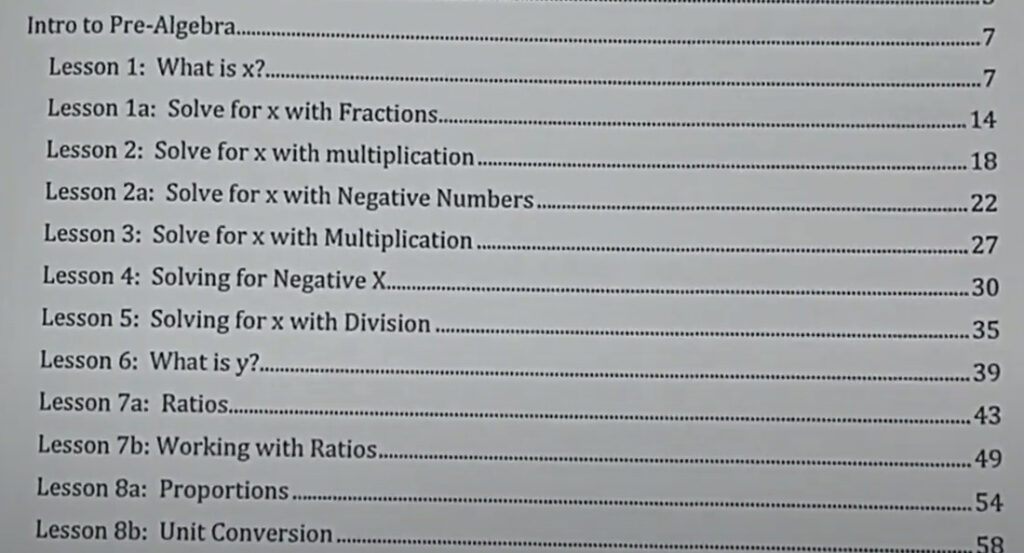
While younger students will probably need to work alongside a parent, the lessons themselves are written to the student at around a 4th grade reading level so most older students should be able to go through them on their own, especially given their friendly and conversational tone.
Each lesson in the series follows a pretty consistent format.
They start off by introducing a concept, typically using a combination of plainspoken English, comparisons and references to everyday objects or ideas and even a good dose of humor to make them more understandable and less mystifying for students.
Following this, lessons then generally provide examples of the concept, such as sample equations or exercises, and carefully guide students through them in a step-by-step way.
As they do so, the book tend to offer conceptual explanations, in particular why certain operations are done and why things are written the way they are and so on.
At times, Learn Math Fast will even play around with its equations, either in order to show how small changes can impact a result or as a way of introducing a particular strategy or tip that students can use to make things easier.

Although the teaching component of a lesson is pretty clearly written and easy to understand, they can be pretty information rich and detailed.
As a result, and depending on the student, their skill and the complexity of the topic, it can take students (and parents) a couple of days to really digest all the information and methods presented in any given lesson.
Following this instruction, students are presented with worksheets to practice what they have learned, which are typically a traditional mix of computational and word problems that take up a page or two.

Sprinkled throughout the book are a number of timed quizzes or tests (45 second, 1 minute, etc) that follow a lesson and test a student’s ability to answer questions quickly and accurately, something that’s a little different than most other conceptual math programs and a skill more in line with procedural programs, such as CLE and Saxon.
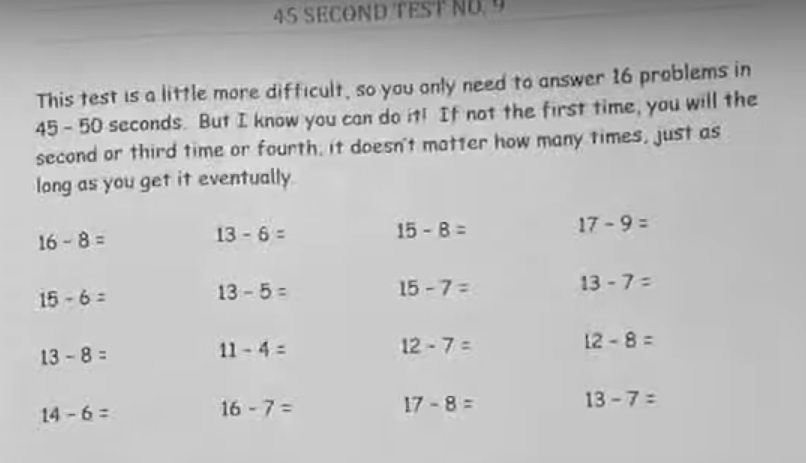
While timed tests aren’t necessarily every student’s (or parent’s) favorite, they can be a good skill-building activity for those interested in preparing for standardized tests down the line or for parents who just want their kids to improve their ability to solve problems quickly.
To their credit, Learn Math Fast recognizes that timing tests can stress students out and recommends that parents drop it if it becomes overwhelming for students.
At the end of each topic or chapter, there is a review test that covers the concept in question, i.e. testing the material covered in all of that topic’s lessons.

Finally, at the end of each book there is a timed and comprehensive final exam that offers a selection of questions that cover all the topics introduced throughout the lessons.
Our Thoughts
Overall, we feel that Learn Math Fast can be a great way to teach math, particularly for students who have had a hard time with math in the past and who are looking for a gentler and more approachable math curriculum.
The program’s casual and conversational tone definitely makes concepts easier to grasp and understand, for both parents and students, and generally makes lessons a lot less stressful for all involved.
The program’s lessons are also straightforward and highly consistent, so students tend to know what to expect each day and there isn’t much in the way of surprises or uncertainty.
Yet, importantly for any math program, although written in an engaging manner, the authors manage to teach concepts completely and thoroughly, refraining from dumbing down the material or skipping over its more complex ideas.
As such, while students may have an easier time learning math concepts compared to some other programs, they will still learn the essential material in an appropriate amount of depth.
We also liked the fact that the program actively encourages independent learning.
With lessons written to the student at an accessible reading level and possessing a consistent format, students who are secure in their reading and comprehension (at a 3rd/4th grade level, for example), should be able to read through lessons on their own.
In fact, in later books Learn Math Fast seems to encourage student independence, suggesting they take their time going through certain topics and even encouraging them to look up answers themselves in the back so they can learn from their mistakes.
With all that said, although Learn Math Facts is an effective and interesting math program, there are some things parents should be aware of.
For one thing, the program follows a rather unique scope and sequence compared to other math programs.
For instance, the program teaches pre-algebra concepts (Vol 3) before it even explores introductory geometry (Vol 4).
Although straying from a common core sequence is not all that unusual in homeschool math programs, it can be something parents may need a little time to adjust to.
Another issue that some students may have is that there isn’t a lot of concept review and revision baked into each lesson in this series, which helps keep it fairly compact and quick moving.
At times when review is recommended or needed, Learn Math Fast tends to simply refer students back to previous books rather than restate the concept.
Consequently, students who tend to benefit from lots of review and revision or concepts over time will probably need to purchase the series rather than just a single book.
How Easy Is Learn Math Fast To Teach?
Learn Math Fast is extremely easy to teach with and learn from.
Its lessons are very understandable and easy to follow and clearly guide parents and students step by step through the exploration of math topics.
Further with more or less everything contained in a single book, there’s no real prep time or planning required when using this program, making it pretty much open and go.
With it’s easy to read texts and intuitive and consistent lessons structure, Learn Math Fast is also a program that can be used independently by students, something that’s good news for busier homeschoolers.
Pros and Cons of the Learn Math Fast System
Pros
Affordable
With each book in the Learn Math Fast System costing less than $50 and many covering several grades worth of learning, the program is quite affordable and should fit most homeschool budgets.
Gentle, easy to understand math instruction
Using plainspoken English, step by step examples and even a dose of humor now and again, Learn Math Fast is a very gentle approach to math that can make even more complex math concepts fairly easy to grasp.
Compact
With no teacher’s guides, student editions, separate workbooks or textbooks to buy, Learn Math Fast is a pretty compact curriculum that is easier than most to manage and store.
Open and go
Lessons in Learn Math Fast are pretty straightforward, clear, consistent and well-structured.
There isn’t much prep work or planning involved in using the program and parents (or students) can essentially pick up a volume and start learning.
Skill-based levels
Books in the Learn Math Fast series are organized around skills and math concepts, rather than grade or age level, which can make them a lot more comfortable for those learning outside a traditional grade progression, such as students who are a bit behind, to use.
Thorough math instruction
Although it makes sure to explain math concepts in a way students will understand and enjoy, Learn Math Fast teaches math professionally and at an appropriate level of depth and comprehensiveness that ensures students learn math concepts as thoroughly as possible.
Can support independent learning
Written to the student in an engaging manner, and with consistent and intuitively structured lessons, as long as students are reading at a 4th grade level they should be able to work more independently with this program, freeing parents to take on the many other tasks homeschools tend to involve.
Cons
Not the most visually stimulating
Although there are some diagrams and pictures here and there (largely in the first volume), Learn Math Now books are largely black and white, text-based and may not be the most interesting math books for parents and students to look at.
Not a lot of built in review of previous concepts
A more concise math program, Learn Math Fast lessons don’t often go over previously learned concepts in detail, instead referring students back to previous books, which can mean an extra step or purchase on their part.
Who is Learn Math Fast Ideal For?
Students who have had a hard time learning math
Some students, particularly those who have had a hard time and struggled with it in the past, can become demoralized and feel that math is just not for them.
These students may benefit greatly from Learn Math Fast’s gentle and easy to understand approach, as its conversational style can seem far less intimidating and scary.
Parents whose skills in math are rusty
Parents if younger students can struggle with teaching math as they may not be very secure in their own knowledge of math.
Learn Math Fast is a fairly guided and well-structured program that requires little math skill or prep on the part of parents.
Students who hate drill and endless reviews
As a conceptual mastery program, there isn’t a lot of review or long drill sessions with Learn Math Fast lessons, which can be very helpful for students who get frustrated by such learning methods.
Those looking for an approachable, conceptual math program
Learn Math Fast is a conceptual math program with an easy to understand, gentler approach than most that can be good for students who need to respond well to this style of instruction.
Busy parents of older students
Written in a casual and straightforward style and pretty intuitively structured, Learn Math Fast can be read and studied by most older students on their own, encouraging greater independence and requiring less time and effort on the part of parents.
Those looking for a compact math curriculum
Largely based around individual textbooks, and with no teacher’s guides or student manuals, Learn Math Fast is relatively simple and affordable for parents to buy, store and manage compare to many other curricula out there.
Homeschools on a budget
For less than $300, with Learn Math Fast parents can purchase an entire curriculum set that teaches math all the way up to HS Geometry.
Largely non-consumable, it can also be used for years, ultimately making the program quite budget-friendly.
Who is it Not Ideal For?
Those looking for a very rigorous and advanced math program
Although it is a complete and thorough math curriculum that explores its math concepts fully, and while students can use it to progress quickly and efficiently through several grades of math, Learn Math Fast isn’t quite as rigorous as programs specifically aimed at advanced math students, such as Beast Academy or Art of Problem Solving.
Students who need a lot of review but don’t want to purchase the whole series
To keep things moving along and to keep the books fairly compact and light, when it comes to review and revision of previously learned concepts Learn Math Fast generally refers students back to lower levels in the series, meaning that students that need to periodically refresh their skills will have to own those books as well.
Fans of more traditional math instruction
Although many parents and students will enjoy the conversational tone and personable style of Learn Math Fast, others may prefer a more formal and neutral textbook approach filled with conventional memoriemzarion and drill exercises.
Price
⭐ 30-day money back guarantee
Note: All prices correct as of writing. All prices in USD.
Compared to most other math programs out there, Learn Math Fast does not require parents to buy a lot of materials or manipulative.
As mentioned previously, there are no teachers editions or workbooks to buy and parents largely just need to purchase the textbooks themselves.
Each volume typically costs around $38.
Because the books refer back to previous editions in order to review concepts, students in upper levels will probably want to purchase those below them, as well.
For this reason, the company (and various retailers) often bundle the books together at a discount.
Volumes 1-4, for example, can be purchased for about $126, while a more or less all inclusive set of all volumes, cards, charts and so on can be picked up for about $250.
As always, we encourage parents to check out the latest prices for the program, as well as look for any deals or offers that may apply.
Or
Is It Worth The Price?
Overall, we feel that Learn Math Fast can provide a lot of value to the right homeschooling family.
For less than $300, parents can purchase a set of curricula that pretty comprehensively covers grades 1-10 math and, as non-consumable, that can be used again with subsequent students.
More than its price, the program offers clear and understandable math instruction using a straightforward, incremental and conversational teaching style to help students grasp and become comfortable with math’s sometimes challenging and abstract concepts.
Consequently, it can be a real boon to students with math phobia or who are behind in their studies, as well as parents who are unsure about their own ability to teach math.
At the same time, however, the program explores math concepts fully and deeply enough for students to get a thorough and complete math education.
It is also a program that supports and even encourages independent learning.
Older students should be able to study and work more on their own with this program, something that is always helpful for busy parents.
Finally, Learn Math Fast is a very compact and easy to use math curriculum with feq moving parts or additional materials for parents to buy, so it can be easier for homeschools to manage.
Bottom Line
Math can be a challenging subject for any homeschool.
With its easy to understand and gentle explanations, step by step, guided approach and through coverage of concepts, Learn Math Fast can be a great way to make math learning more effective, comfortable and (perhaps most importantly) tear-free for all involved.

About the Author
David Belenky is a freelance writer, former science and math tutor and a tech enthusiast. When he’s not writing about educational tech, he likes to chill out with his family and dog at home.
